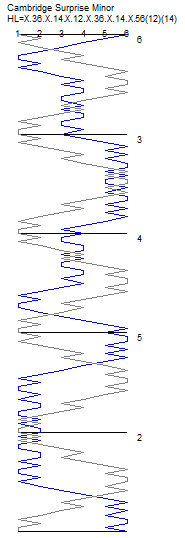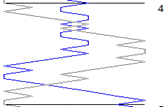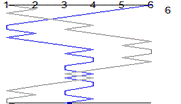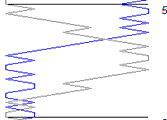Learning Methods by Place Bells
By Anonymous!
Learning methods by “Place Bells”
When I learned to ring we learned the blue line and the “starts” for different bells that we might ring. Not being allowed to ring the heavy bells meant not bothering to learn the starts for them. How often do we see experienced ringers asking “where do I start on this bell?” What it means is they haven't learnt the method thoroughly, but they may well still ring it well with accurate striking. So why bother with the place bell approach at all? It depends on your ambition to ring more complex methods and in particular “spliced” where there will be more than one method in a touch. In any case it is always useful to know what people are on about when they talk about place bells.

Starting positions in Grandsire Doubles
The number 5 says where the 5 starts, 3 where the 3 starts etc...
2 isn't shown because it is in the hunt.
The section of line that starts with 5 and ends with 3 is known as the work for 5ths place bell, that between 3 and 4 is the work for 3rds place bell and that between 4 and the end is the work for 4ths place bell.
All this might seem irrelevant when ringing a plain course and most people ring Grandsire Doubles quite happily never thinking of place bells at all. Nevertheless it is good preparation for more complex methods to start thinking of place bells in something you can ring rather than something you would like to ring.
When a call is made people usually think about the cycle of work and not place bells. This is easy in simple methods like this but much harder in complex ones.
The cycle of work in Grandsire Doubles:
3rds → 54 down → 45 up → 3rds etc...
So for example, if at a bob you make 45 up you know the next work is 3rds. Another way to look at it is 45 up as the start for 5ths place bell, and the next place bell is 3rds place bell.
The cycle of work in place bells is 5 → 3 → 4 → 5 etc...

The cycle of work in Plain Bob Minor
2nds → 43 down → 65 down → 56 up → 34 up → 2nds etc... OR
Place bells sequence is 24653 → 24653 etc...
Usually we learn that if at a bob we run out we do seconds next time OR
Run out to become 3rds place bell, at the next lead become 2nds place bell.
Called to make the bob we learn the next work is 65 down OR
Making the bob we become 4ths place bell, at the next lead become 6ths place bell.
Called to run in we do 43 down next time OR
Run in to become 2nds place bell, at the next lead become . . . ?
So far no real need to complicate things with place bells , it is much easier to learn the simple rules. But when you can ring a simple method it is good preparation for complex ones to practise thinking about place bells.
If you want to be a conductor and put people right when they make a mistake it is vital to know what different place bells do, after all they won't be ringing the same bit of line as you, well they shouldn't be.
 Cambridge Surprise Minor is likely to be the first complex method you attempt.
Cambridge Surprise Minor is likely to be the first complex method you attempt.
You can learn it as a complete line, and when you do, try to learn the Place bell sequence is 63452(6 . . . ) or 26345(2 . . .) etc...
Should you go on to Cambridge Surprise Major the place bell sequence is 2673485,
Royal 260734895 and Maximus 260E7348T95. Why am I bothering you with this? You can see two patterns in these: 526 always come together as do 34 and beyond minor 7348 stay in that order with the bigger bells in not so obvious a position. Knowing this pattern helps you learn the full sequence for higher numbers, there being familiar bits in there. Nothing wrong with a bit of ambition to ring on higher numbers.
Back to Minor, you could learn it in bits, in the wrong order.

 2
2 


But you must learn the place bell sequence as well.
When you come to ring it by place bell, as you start on the 2 say to yourself “next lead 6ths place bell”. You will be surprised how your brain remembers that much better than trying to work out what to do as you come to the end of that lead.
If you cannot remember what to do next and the conductor spots your uncertainty, or even better you ask, she will tell you which place bell you are and you should know what to do. It is impossible to put you right just by saying what to do, as saying for example “dodge in 12” could be in a variety of places on the line, so she will have to give more instructions and which place bell is the best option.
When I learn a new method I start by drawing out the complete line, then learn it, and then on a fresh sheet of paper try to draw it again from memory. When I cannot remember, a quick look at the correct line starts me off again. After becoming confident I can draw the line starting from say the 2, I then draw the line out starting from a different position. When I can draw the line starting with any bell, I draw out each bell separately as in the Cambridge above. Try it, it might work for you. Time consuming it might be, but worth it.
For spliced I write out each method in turn e.g. 2nds place Cambridge, 2nds place Bourne, 3rds place Cambridge, 3rds place Bourne etc... Then knowing that the place bell sequence in Cambridge is 26345 and in Bourne is 25436 (the reverse of Cambridge) I can ring them spliced together.
Good luck.
